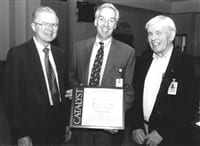The Front-door Perspective Baystate’s Emergency Department Expansion Improves Service And Comfort
It’s natural, Dr. Philip Henneman says, to form an impression about a place moments after entering it.
If that’s true, then the people running the busiest hospital emergency department in Massachusetts want to put their best foot forward.
But there’s plenty more to Baystate Medical Center’s $1.8 million emergency department expansion project than aesthetics, said Henneman, chair of Emergency Medicine for Baystate Health System and Tufts University School of Medicine.
“Emergency departments across the country are growing, and we at Baystate are no different,” Henneman said. “We’re seeing over 107,000 emergency patients each year, and that makes us the biggest emergency department in Massachusetts. It’s a busy place. These renovations are giving us the opportunity to improve the quality of care and safety for our patients.”
It’s a change patients will see mainly from a “front-door perspective,” he noted, but, considering that they’re registered and triaged at that spot, it’s an area of critical decisions — an area in which those decisions will be made more accurately and efficiently once the project is complete.
Multiple Facets
Deb Provost, director of Baystate’s emergency department, said the expansion project aims to add capacity, improve patient satisfaction at all stages, and provide for staff satisfaction as well.
The initiative will result in new waiting areas for both pediatrics and adults, an expanded and improved triage area, a new registration area, and expanded staff lounges, or what the hospital calls “quiet space,” Provost said. “We’re trying to provide an area where staff can go after dealing with a significant trauma so they have time to collect their thoughts, deal with the situation, and go back to work after some private time.”
What patients will notice, however, are the other three facets, Provost said.
“This will make it easier for patients,” she said. “It’ll be aesthetically pleasing, and, while the ER is never quiet, hopefully it will make for a calmer atmosphere. We know what people are dealing with when they come here, so we’re trying to make it a better experience for patients and their families.”
Triage space will be expanded and the process streamlined. “There will be more opportunities for triage, so patients will be seen and evaluated for their level of acuity faster, so sicker patients can be rushed in more quickly,” Henneman said. Urgent care will also be expanded from eight to 12 beds, also facilitating the flow of traffic.
An increased number of volunteers and patient advocates will be on hand to help explain medical situations to patients and their families, while a reassessment booth will be staffed by professionals who will monitor people in the waiting room who have already registered, in case their condition changes and they need higher-priority service.
“These staff members will sit with patients and reassess them so, if they’re getting sicker or their condition changes, we can move them in and see them right away,” Henneman said. “We just don’t want the registration area to be a bottleneck in any way, so we’re trying to move patients through the process much more quickly.”
While creating a more efficient flow, the hospital is also placing more emphasis on privacy, a key consideration now that the patient-privacy regulations of the Health Insurance Portability and Accountability Act (HIPAA) are in effect at all hospitals.
“The renovations we’ve done in urgent care have created privacy for each patient,” Henneman said. “The old layout was a big room filled with curtains. What we’re doing now is putting in walls that provide some audio as well as visual privacy for the patients.”
Keep Working
To make room for the expanded services, the hospital moved the footprint of the department into the parking area, Provost said, and all phases of the project should be complete by early 2004, hopefully as early as January.
One of the biggest challenges, Henneman noted, continues to be the fact that the emergency department was not allowed to reduce capacity during the project — so the expansion has gone on around the day-to-day activity of the ER.
“We could not close beds, and we could not have it negatively impact patient care,” he said. “So it forced some multi-level planning. It would have been easier to close the emergency department for three months, but that wouldn’t work in this community.”
That’s because the overall goal was to improve quality of care, he said — and that would be undermined by even a temporary loss of capacity.
“From the time they walk in the front door, we’re improving how we manage patients and what we do for them,” Henneman said.
“We’re doing this to make the patients’ experience better,” Provost added. “Coming to the emergency department is never a choice. What we’re trying to do is improve the experience.”



Comments are closed.